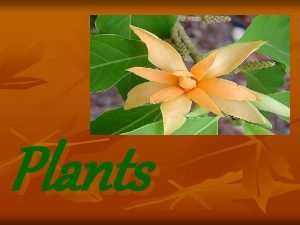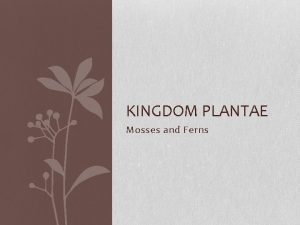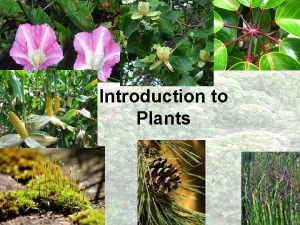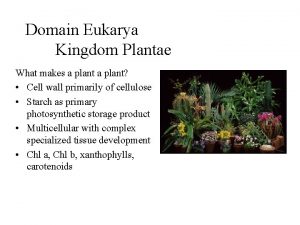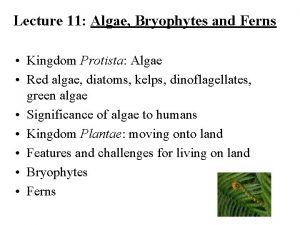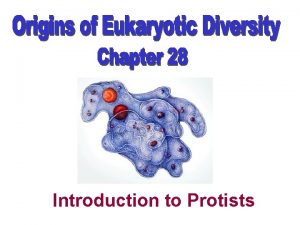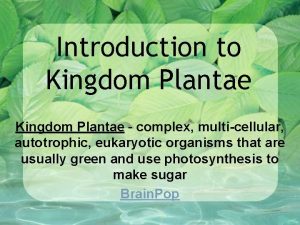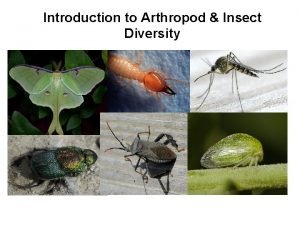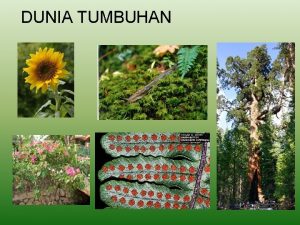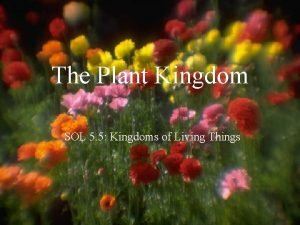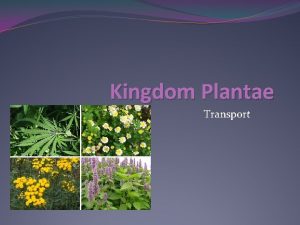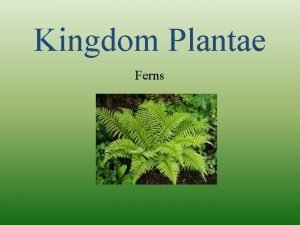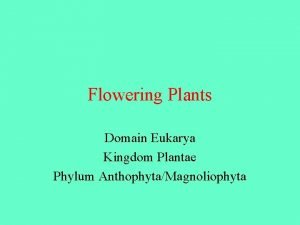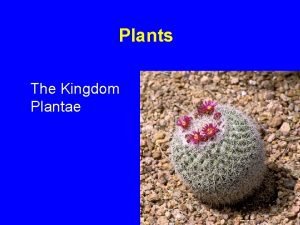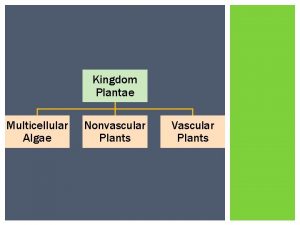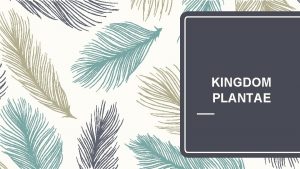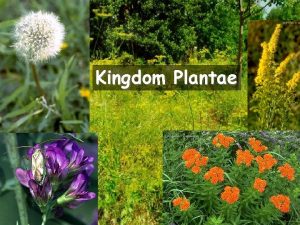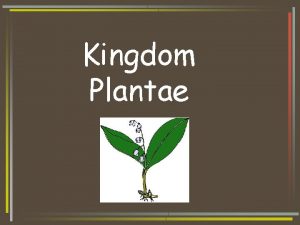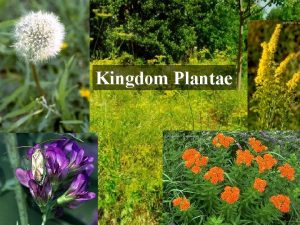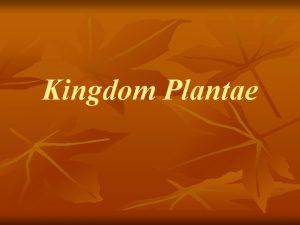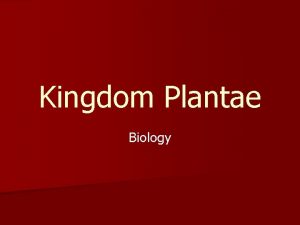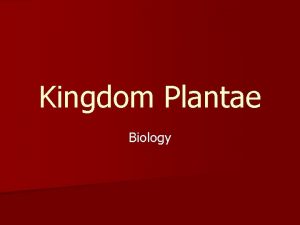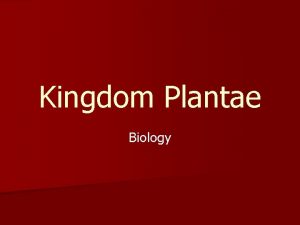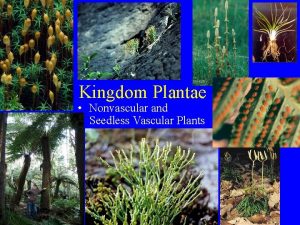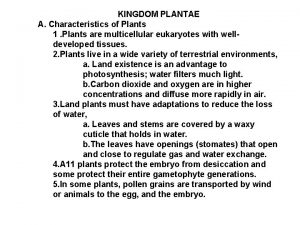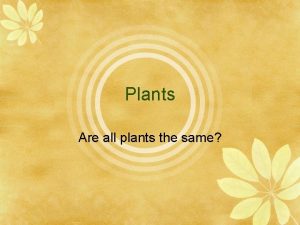Kingdom Plantae Kingdom Plantae Overview All plants share
































- Slides: 32

Kingdom Plantae

Kingdom Plantae Overview • All plants share the common ancestor of green algae • Plants have adapted to live on land • Characteristics: – The same photosynthetic pigments in similar chloroplasts – Cell walls with cellulose – Food stored as starch – Multicellular eukaryotes

Plant Classification • Four major groups based on differences in: – Water-conducting tissues – Seeds – Flowers

Cladogram of the major plant types Cone-bearing plants Ferns and their relatives Flowers; Seeds Enclosed in Fruit Mosses and their relatives Seeds Water-Conducting (Vascular) Tissue Green algae ancestor (a protist) Flowering plants

Types of Plants • Non-Vascular – lack vascular tissue for long-distance transportation of water and solutes; lack true roots, leaves or stems • Vascular – Have tissue specialized for the longdistance transport of water and solutes through a plant; have true roots, leaves and stems • Much like a circulatory system

Non-vascular Plants • Called Bryophytes – Includes: Mosses & Liverworts – Cannot retain water or deliver it to other parts of the plant body – Water must be absorbed directly from the surrounding air or another nearby source – Small, short, require water for sperm/egg union






Life cycle of Mosses Haploid (N) Diploid (2 N) Spores (N) MEIOSIS Protonema (young gametophyte) (N) Male gametophyte Female gametophyte Mature sporophyte (2 N) Capsule (sporangium) Antheridia Sperm (N) Gametophyte (N) Archegonia Young sporophyte (2 N) Zygote (2 N) Gametophyte (N) Sperm (N) Egg (N) FERTILIZATION

Nonvascular Plants Video Liverwort video portal

Vascular Plants • 90% of all modern plants have vascular tissue & have true roots, leaves, & stems • Characterized by the presence of a vascular system composed of two types of specialized tissue – Xylem – tissue that carries the water and dissolved minerals upward in a plant • made of dead cells – Phloem – tissue conducts sugars and some water upward and downward in a plant (sap) • made of living cells • Both xylem & phloem are distributed throughout the roots, leaves & stem


• Roots – Underground organs that absorb water and minerals; anchor plant • Leaves – Photosynthetic organs that contain one or more bundles of vascular tissue gathered into veins made of xylem and phloem; contain pores (stomata) for exchange of CO 2 and O 2 • Stems – Supporting structures that connect roots and leaves, carrying water and nutrients between them.

Vascular plants – 2 types • Seedless – Ferns produce spores (not seeds) by meiosis and store them in cases on the underside of the leaf (frond) – Once spores are released, they germinate into small plants if they reach moist ground – Other examples • Club mosses & horsetails • Seeded – Plants produce male and female gametes (pollen/egg) which join to form an embryo. A protective seed coat surrounds the embryo and provides nourishment during early stages of development.

Undersides of fern fronds, showing the bundles (sori) that contain spores. Ferns do not produce flowers or seeds!




Life cycle of a fern MEIOSIS Sporangium (2 N) Haploid gametophyte (N) Diploid sporophyte (2 N) Frond Spores (N) Mature sporophyte (2 N) Developing sporophyte (2 N) Antheridium Young gametophyte (N) Mature gametophyte (N) Sperm Gametophyte (N) Egg Sporophyte embryo (2 N) FERTILIZATION Archegonium

Seedless Plants Video

Seeded Vascular Plants can be further divided into two groups • Gymnosperms – vascular plants that produce seeds lacking a protective fruit • Angiosperms • gymnosperm means “naked seed” • Eg) conifers – firs, spruce, pines, cedar – vascular plants that produce seeds enclosed and protected by a fruit • Are flowering plants • Oak, tulip, grass, corn, tomatoes

Examples of Gymnosperms

Examples of Angiosperms

Seeded Plants #1 #2

Parts of a Flower • Flowers– used in sexual reproduction of Stamen angiosperms – Pistil (female part) • Ovary (produce eggs) • Style (stalk that holds stigma) • Stigma (sticky pollen collector) Anther Filament Stigma Style Pistil Ovary – Stamen (male part) • Anther (produce pollen) • Filament (stalk that holds anther) – Petals – attract pollinators – Sepals – protect young flower as it develops Petal Sepal

Parts of a Leaf • Cuticle – layer of waxes on outer surface that helps prevent loss of water • Epidermis – one cell thick layer that secretes the cuticle • Stomata – openings for diffusion • Guard cells – two cells on either side of stomata that allow diffusion of CO 2, oxygen and water vapor into and out of plant for photosynthesis

Guard cells Inner cell wall Stoma Open Stoma Closed

Cuticle Veins Epidermis Xylem Phloem Vein Epidermis Stoma Guard cells

Relative numbers of plant species Cone-bearing plants 760 species (gymnosperms) Ferns and their relatives 11, 000 species (seedless vascular) Mosses and their relatives 15, 600 species (nonvascular) Flowering plants 235, 000 species (angiosperms)
 Plantae
Plantae Domain: eukarya kingdom: protista
Domain: eukarya kingdom: protista Cool protists
Cool protists Old kingdom middle kingdom new kingdom
Old kingdom middle kingdom new kingdom Nnn ruled
Nnn ruled Youtube egypt
Youtube egypt Old kingdom middle kingdom new kingdom
Old kingdom middle kingdom new kingdom Dryolar
Dryolar Phylogenetic tree of kingdom plantae
Phylogenetic tree of kingdom plantae Characteristics of kingdom plantae
Characteristics of kingdom plantae Character of plants
Character of plants Lycodiophyta
Lycodiophyta Domain of kingdom plantae
Domain of kingdom plantae Monera, protista, fungi, plantae animalia
Monera, protista, fungi, plantae animalia Dunia plantae
Dunia plantae Protista characteristics chart
Protista characteristics chart Prokaryotic protista
Prokaryotic protista Kingdom plantae
Kingdom plantae Cladogram of 6 kingdoms
Cladogram of 6 kingdoms Subkingdom tracheobionta
Subkingdom tracheobionta Euglenophyta
Euglenophyta Plantae multicellular
Plantae multicellular Kingdom plantae chart
Kingdom plantae chart Bryopyta
Bryopyta Parts of flower
Parts of flower Plantae kingdom characteristics
Plantae kingdom characteristics Plantae kingdom
Plantae kingdom Fern kingdom
Fern kingdom Flowering plants domain
Flowering plants domain Nonvascular plants
Nonvascular plants Plantae kingdom chart
Plantae kingdom chart Plantae multicellular
Plantae multicellular Plantae mobility
Plantae mobility







